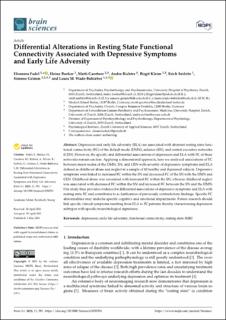Please use this identifier to cite or link to this item:
https://doi.org/10.21256/zhaw-22643| Publication type: | Article in scientific journal |
| Type of review: | Peer review (publication) |
| Title: | Differential alterations in resting state functional connectivity associated with depressive symptoms and early life adversity |
| Authors: | Fadel, Eleonora Boeker, Heinz Gaertner, Matti Richter, Andre Kleim, Birgit Seifritz, Erich Grimm, Simone Wade-Bohleber, Laura Maria |
| et. al: | No |
| DOI: | 10.3390/brainsci11050591 10.21256/zhaw-22643 |
| Published in: | Brain Sciences |
| Volume(Issue): | 11 |
| Issue: | 5 |
| Page(s): | 591 |
| Issue Date: | May-2021 |
| Publisher / Ed. Institution: | MDPI |
| ISSN: | 2076-3425 |
| Language: | English |
| Subjects: | Depression; Early life adversity; Functional connectivity; Resting state fMRI |
| Subject (DDC): | 616.8: Neurology, diseases of nervous system |
| Abstract: | Depression and early life adversity (ELA) are associated with aberrant resting state functional connectivity (FC) of the default mode (DMN), salience (SN), and central executive networks (CEN). However, the specific and differential associations of depression and ELA with FC of these networks remain unclear. Applying a dimensional approach, here we analyzed associations of FC between major nodes of the DMN, SN, and CEN with severity of depressive symptoms and ELA defined as childhood abuse and neglect in a sample of 83 healthy and depressed subjects. Depressive symptoms were linked to increased FC within the SN and decreased FC of the SN with the DMN and CEN. Childhood abuse was associated with increased FC within the SN, whereas childhood neglect was associated with decreased FC within the SN and increased FC between the SN and the DMN. Our study thus provides evidence for differential associations of depressive symptoms and ELA with resting state FC and contributes to a clarification of previously contradictory findings. Specific FC abnormalities may underlie specific cognitive and emotional impairments. Future research should link specific clinical symptoms resulting from ELA to FC patterns thereby characterizing depression subtypes with specific neurobiological signatures. |
| URI: | https://digitalcollection.zhaw.ch/handle/11475/22643 |
| Fulltext version: | Published version |
| License (according to publishing contract): | CC BY 4.0: Attribution 4.0 International |
| Departement: | Applied Psychology |
| Organisational Unit: | Psychological Institute (PI) |
| Appears in collections: | Publikationen Angewandte Psychologie |
Files in This Item:
| File | Description | Size | Format | |
|---|---|---|---|---|
| 2021_Fadel_Differential_Alterations_in_Resting_State_Functional_Connectivity_Brain_Sciences.pdf | 1.25 MB | Adobe PDF |  View/Open |
Show full item record
Fadel, E., Boeker, H., Gaertner, M., Richter, A., Kleim, B., Seifritz, E., Grimm, S., & Wade-Bohleber, L. M. (2021). Differential alterations in resting state functional connectivity associated with depressive symptoms and early life adversity. Brain Sciences, 11(5), 591. https://doi.org/10.3390/brainsci11050591
Fadel, E. et al. (2021) ‘Differential alterations in resting state functional connectivity associated with depressive symptoms and early life adversity’, Brain Sciences, 11(5), p. 591. Available at: https://doi.org/10.3390/brainsci11050591.
E. Fadel et al., “Differential alterations in resting state functional connectivity associated with depressive symptoms and early life adversity,” Brain Sciences, vol. 11, no. 5, p. 591, May 2021, doi: 10.3390/brainsci11050591.
FADEL, Eleonora, Heinz BOEKER, Matti GAERTNER, Andre RICHTER, Birgit KLEIM, Erich SEIFRITZ, Simone GRIMM und Laura Maria WADE-BOHLEBER, 2021. Differential alterations in resting state functional connectivity associated with depressive symptoms and early life adversity. Brain Sciences. Mai 2021. Bd. 11, Nr. 5, S. 591. DOI 10.3390/brainsci11050591
Fadel, Eleonora, Heinz Boeker, Matti Gaertner, Andre Richter, Birgit Kleim, Erich Seifritz, Simone Grimm, and Laura Maria Wade-Bohleber. 2021. “Differential Alterations in Resting State Functional Connectivity Associated with Depressive Symptoms and Early Life Adversity.” Brain Sciences 11 (5): 591. https://doi.org/10.3390/brainsci11050591.
Fadel, Eleonora, et al. “Differential Alterations in Resting State Functional Connectivity Associated with Depressive Symptoms and Early Life Adversity.” Brain Sciences, vol. 11, no. 5, May 2021, p. 591, https://doi.org/10.3390/brainsci11050591.
Items in DSpace are protected by copyright, with all rights reserved, unless otherwise indicated.